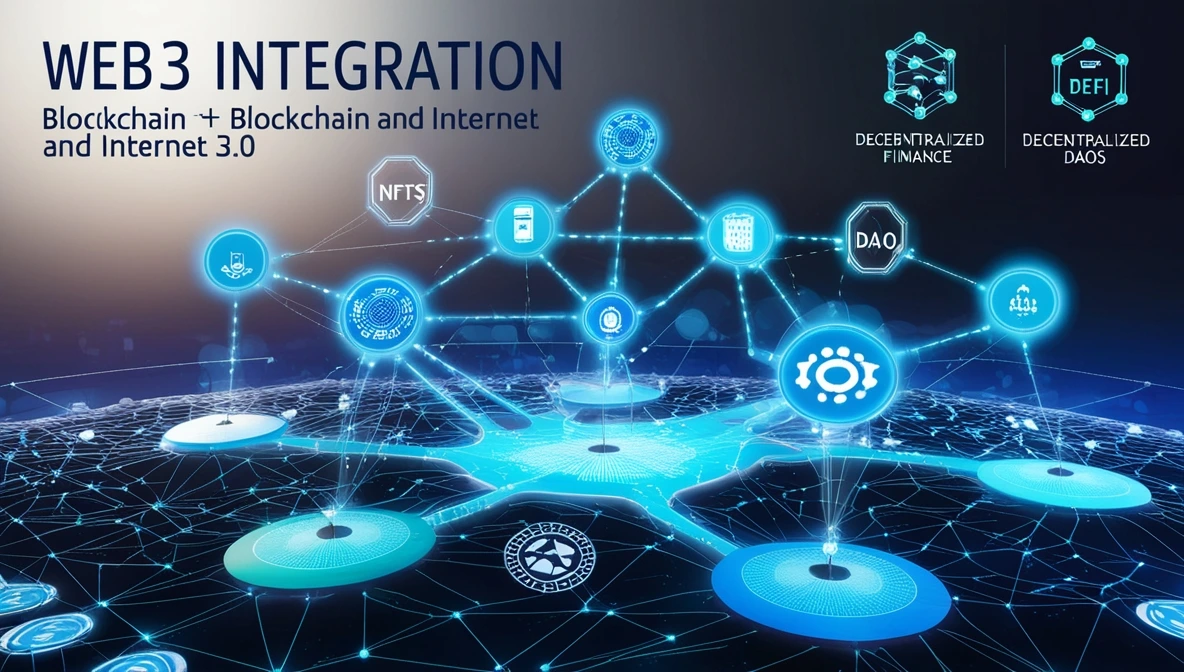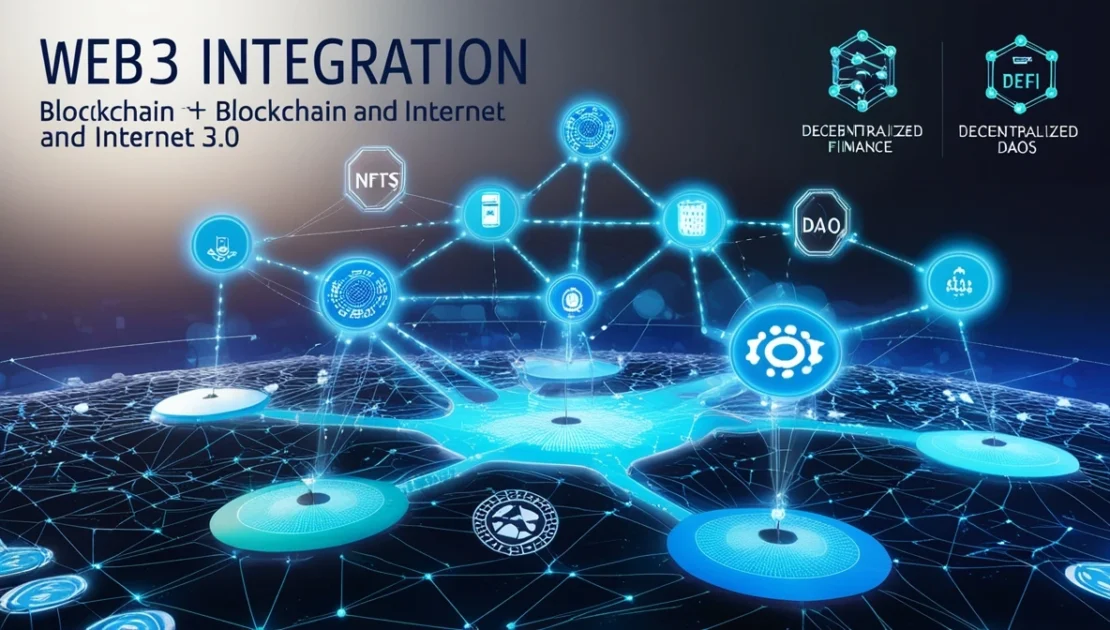Web3 Integration: Bridging Blockchain and Internet 3.0
The digital landscape is undergoing a massive transformation, and one of the most significant developments is the integration of Web3 with blockchain technology. This shift from Web 2.0 to Web 3.0, also known as the decentralized web, is set to revolutionize how we interact with the internet. As we transition into a new era of digital ownership, transparency, and autonomy, it’s essential to understand what Web3 is and how blockchain plays a critical role in shaping the internet’s future.
What is Web3?
Web3 refers to the next generation of the internet, where decentralization, blockchain, and cryptographic security are the foundational technologies. Unlike Web 2.0, where large tech companies control vast amounts of user data and digital infrastructure, Web 3 aims to give individuals more control over their data and online interactions. It emphasizes peer-to-peer networks, removing the need for central authorities and intermediaries.
At its core, Web3 integrates blockchain technology, allowing for the creation of decentralized applications (dApps) that run on distributed networks rather than centralized servers. This shift enables greater privacy, security, and user empowerment.
How Blockchain Powers Web3
Blockchain is the backbone of Web3. It provides a distributed ledger system that records transactions in a transparent, immutable way. Here’s how blockchain supports the core principles of Web3:
- Decentralization: Rather than storing data in centralized databases controlled by companies, blockchain distributes data across a network of nodes. This ensures that no single entity has complete control over the system.
- Security: Blockchain uses cryptographic techniques to secure data, making it nearly impossible for unauthorized parties to alter records without consensus from the network.
- Transparency: Transactions on a blockchain are publicly accessible, ensuring that all interactions are transparent and auditable, a key principle of Web3.
- Digital Ownership: Web3 empowers users to own their data and digital assets through technologies like non-fungible tokens (NFTs) and decentralized identifiers (DIDs). Blockchain ensures that ownership can be verified without relying on third-party platforms.
Key Use Cases of Web3 Integration
Web3 is already reshaping industries through various blockchain-powered innovations. Here are some of the most exciting use cases:
1. Decentralized Finance (DeFi)
DeFi platforms offer financial services such as lending, borrowing, and trading without intermediaries. By leveraging blockchain, DeFi allows users to access financial products securely and transparently, often with better terms than traditional finance.
2. Non-Fungible Tokens (NFTs)
NFTs are digital tokens representing ownership of unique items like art, music, and virtual real estate. By utilizing blockchain, Web3 enables secure, verifiable ownership of digital assets, transforming industries like gaming, collectibles, and entertainment.
3. Decentralized Autonomous Organizations (DAOs)
DAOs are blockchain-based organizations governed by code rather than traditional hierarchies. Members can vote on decisions through tokens, ensuring that no single entity has undue influence. This concept is revolutionizing how businesses and communities are structured.
4. Metaverse
The metaverse, a virtual world where users can interact in real time, is a cornerstone of Web3. Powered by blockchain, the metaverse allows for true ownership of virtual assets, enabling an economy driven by digital goods and services.
Benefits of Web3 Integration
The integration of Web3 with blockchain technology offers numerous advantages:
- Data Privacy: Users regain control of their personal information, reducing the risk of data breaches and misuse.
- Elimination of Middlemen: Web3 removes intermediaries, reducing transaction costs and increasing efficiency across various sectors.
- Inclusive Economy: With decentralized platforms, more individuals worldwide can participate in the global economy without traditional barriers.
- Enhanced Security: Blockchain’s cryptographic security makes hacking and fraud significantly more difficult.
Challenges Facing Web3
While Web3 offers immense potential, its adoption faces certain challenges:
- Scalability: Current blockchain infrastructure struggles with high transaction volumes, leading to slow processing times and high fees.
- User Experience: Web3 applications are often less user-friendly than traditional web platforms, creating barriers for mainstream adoption.
- Regulatory Uncertainty: Governments around the world are still figuring out how to regulate decentralized platforms, creating a layer of uncertainty for users and developers alike.
The Future of Web3 and Blockchain
As technology advances, Web3 will become more scalable, secure, and accessible. Innovations like Layer-2 solutions, cross-chain interoperability, and zero-knowledge proofs are making blockchain-based systems faster and more efficient. These advancements are laying the groundwork for a fully decentralized internet that offers unparalleled freedom and security.
In the near future, Web3 integration will not only bridge blockchain and the internet but will also redefine how we live, work, and interact online. The internet of tomorrow promises to be a place where users have ownership over their digital lives, reshaping industries from finance and art to governance and beyond.
Conclusion
Web3 represents the next evolution of the internet, and blockchain is the critical infrastructure driving this transformation. By providing a decentralized, secure, and transparent platform, blockchain enables the creation of a more equitable digital world where users have control over their data and digital assets. As Web3 continues to evolve, its integration with blockchain will undoubtedly shape the future of the internet, ushering in a new era of connectivity, autonomy, and innovation.
Here are four FAQs related to Web3 integration:
1. What is Web3 integration?
Web3 integration refers to the use of blockchain technology to create a decentralized internet where users control their data and digital assets without intermediaries.
2. How does blockchain power Web3?
Blockchain provides a secure, transparent, and decentralized network that supports Web3 applications, ensuring user privacy, ownership, and data integrity.
3. What are some use cases of Web3?
Web3 is used in decentralized finance (DeFi), NFTs, decentralized autonomous organizations (DAOs), and virtual worlds like the metaverse, enhancing digital interaction and ownership.
4. What challenges does Web3 face?
Web3 faces challenges like scalability, user experience, and regulatory uncertainty, which slow down its adoption but are being addressed through technological advancements.

